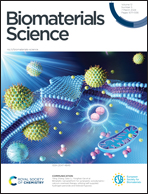Antifibrotic activity of carbon quantum dots in a human in vitro model of non-alcoholic steatohepatitis using hepatic stellate cells†
Abstract
Around 33% of the global population suffers from non-alcoholic fatty liver disease (NAFLD). From these patients, 30% of them progress into non-alcoholic steatohepatitis (NASH), the critical point where lack of treatment leads to cirrhosis and hepatic failure. Moreover, to date, there are no approved therapeutic options available for NASH. It is known that hepatic stellate cell (HSC) activation contributes the most to hepatic disfunction, leading to reactive oxygen species (ROS) accumulation and chronic inflammation, and that the use of nanomaterials to deliver antioxidants may have potential to reduce the activity of activated HSCs. Therefore, we implemented a human in vitro co-culture model in which we take into consideration two factors related to NASH and fibrosis: human hepatic stellate cells from a NASH diagnosed donor (HHSC-N) and peripheral blood mononuclear cells (PBMCs), particularly lymphocytes. The co-cultures were treated with: (1) carbon quantum dots (CD) or (2) lactoferrin conjugated CD (CD-LF) for 24 h or 72 h. CD and CD-LF treatments significantly downregulated profibrotic genes’ expression levels of ACTA2, COL1A1, and TIMP1 in co-cultured HHSC-N at 72 h. Also, we assayed the inflammatory response by quantifying the concentrations of cytokines IL-22, IL-10, IFN-γ and IL-4 present in the co-culture's conditioned media whose concentrations may suggest a resolution-associated response in progress. Our findings may serve as a starting point for the development of a NASH treatment using bio-nanotechnology.



 Please wait while we load your content...
Please wait while we load your content...